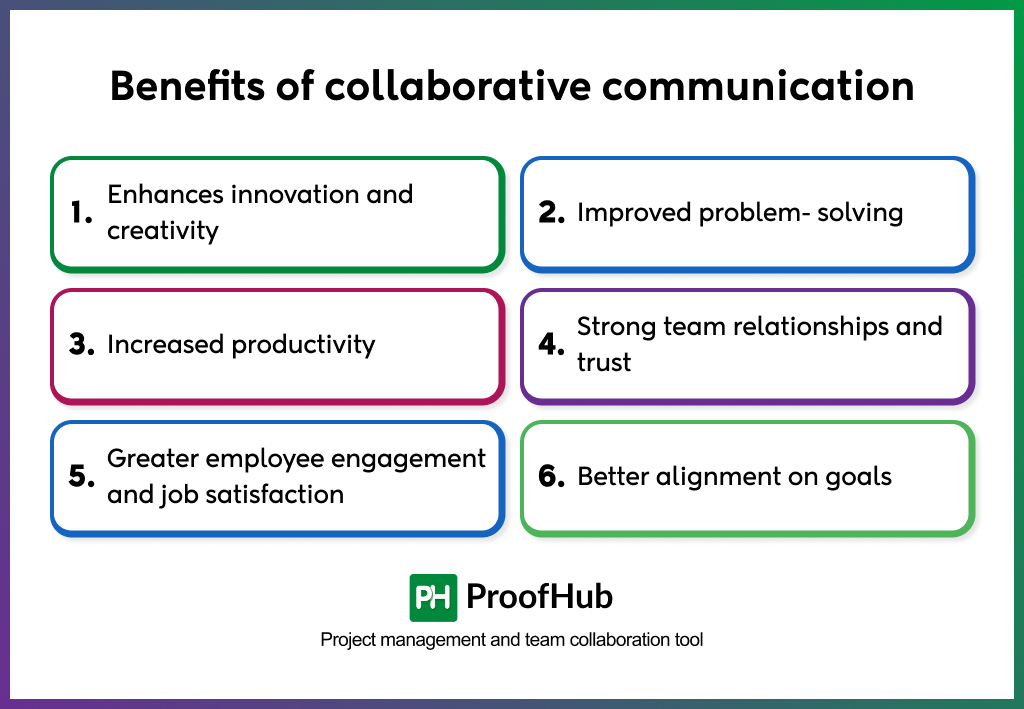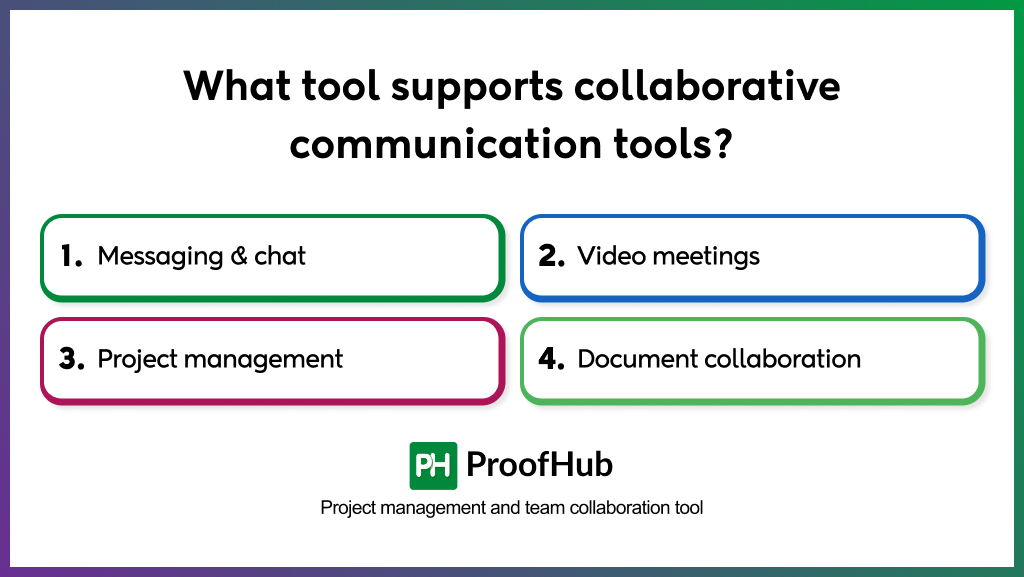
Collaborative communication is a strategic approach in which team members exchange information openly and build upon each other’s ideas to achieve shared goals. It transforms group effort by creating a cohesive, transparent, and innovative work environment. This means teams talk through challenges together, share feedback freely, and combine their strengths. The result is better decisions, fewer misunderstandings, and a stronger sense of shared purpose.
This guide covers its core definition, the tangible benefits it delivers, and the practical strategies, examples, and tools needed to implement it successfully.
What is collaborative communication?
Collaborative communication is the seamless exchange of information and open discussion among team members and stakeholders to achieve a common goal. It involves sharing ideas, providing feedback, and knowing each other’s perspectives in a way that promotes mutual respect and contributes positively towards shared objectives. It enables team members to think constructively and empowers them to see the bigger picture.
Unlike other communication styles, it offers more than transactional exchanges; it promotes a culture where feedback, clarification, and shared ownership accelerate decision-making and reduce misunderstandings among team members.
What are the benefits of collaborative communication?
Collaborative communication enhances innovation and creativity by considering different perspectives, which leads to creative solutions. It also improves problem-solving and increases the productivity of the team members by improving coordination between team members.

Let’s explore these benefits in detail:
1. Enhances innovation and creativity
Open and collaborative communication accelerates innovation by fostering an environment where diverse ideas and perspectives can flourish freely. When team members engage in continuous and meaningful communication, they bring various perspectives to the table.
The multiple thoughts challenge the conventional approaches and encourage out-of-the-box thinking. By actively listening to every team member’s ideas and building on each other’s contributions, teams can transform raw ideas into something that individual efforts can not achieve.
According to a study, “An Empirical Study: The Impact of Collaborative Communications on New Product Creativity That Contributes to New Product Performance” conducted by Henry M. H. Chan and Vincent W. S. Cho in 2022, it was found that collaborative communication enhances productivity by enabling faster, clearer, and more effective information exchange within and across teams. It also states that collaborative communication reduces misunderstandings and minimizes errors, which ultimately improves new product performance.
2. Improved problem-solving
A collaborative approach brings collective intelligence together. Open and transparent discussions allow members to draw from diverse skills, experiences, and insights to tackle challenges from multiple angles. Problems are approached through different angles, which leads to practical solutions. This also promotes a culture where challenges are viewed as a shared responsibility rather than a burden for some.
3. Increased productivity
Team’s productivity increases when open communication creates clarity and alignment across the group. When information is exchanged freely and accurately, the team members understand their roles, responsibilities, and deadlines. Teams can easily coordinate tasks effectively, identify potential bottlenecks early, and get real-time feedback, which prevents miscommunication and slows down progress.
4. Strong team relationships and trust
Collaborative communication builds strong trust by creating a supportive atmosphere where individuals feel respected and valued. Trust grows when transparency is maintained and people consistently follow through on commitments shared during collaborative exchanges. As trust builds, team members become more willing to share ideas, take risks, and provide constructive feedback without fear of judgment.
5. Better employee engagement and job satisfaction
When team members feel heard and included in decision-making, their engagement naturally increases. This involvement promotes more commitment to tasks and organizational goals. Regular and transparent communication allows individuals to seek support, celebrate achievements, and address challenges as they arise, which reduces frustration and feelings of isolation.
6. Better alignment on goals
The collaborative communication ensures all team members stay aligned with the organization’s objectives and project goals by providing clarity on expectations and priorities. Regularly discussing goals and progress fosters a shared understanding of what success looks like and how individual contributions fit into the broader vision. This consistent alignment helps prevent efforts from diverging, ensuring everyone works toward common objectives with a unified sense of purpose.
How to build a collaborative communication culture in teams?
To build a collaborative communication culture, establish trust and psychological safety so that team members feel comfortable sharing ideas and feedback. Encourage open and transparent dialogue where diverse opinions are valued and conflicts are resolved constructively. Align everyone around shared goals and ensure clarity in roles and expectations.
Provide the right tools and platforms that make information sharing and teamwork easy. Finally, invest in communication and collaboration training to help employees develop the skills needed to work effectively across teams.

The following are some of the ways to build a collaborative communication culture-
1. Keep communication transparent
Clear communication fosters trust and openness among team members. Encourage members to consistently share relevant information, feedback, and updates so everyone has access to the same knowledge. Encouraging transparency at all levels, from leadership to individual contributors, strengthens relationships that result in effective problem-solving and decision-making.
2. Prioritize conflict resolution
When disagreements are handled openly and respectfully, honesty and trust deepen among team members. Establish clear processes for resolving issues and encourage a problem-solving mindset. This approach transforms conflicts into opportunities for learning and stronger collaboration rather than becoming a barrier to communication.
3. Promote inclusive participation
Inclusive participation creates a safe environment where individuals feel comfortable contributing, regardless of role or background. Ensure that every team member’s voice is heard and valued. Encouraging diverse perspectives leads to richer ideas, better decisions, and a stronger sense of ownership within the team.
4. Practice active listening
Active listening prevents misunderstandings, reduces conflicts, and fosters mutual trust. It ensures that team members understand and value each other’s contributions. When individuals feel heard, they engage more openly, share ideas, and collaborate effectively. Encouraging active listening within teams enhances clarity, strengthens relationships, and creates an environment where collaboration can thrive.
5. Lead by example
Leaders set the tone and standards for how communication occurs within teams. When leaders model respectful, transparent, and inclusive communication, they demonstrate the behaviours they expect from others. It creates a ripple effect in the organization. By actively engaging in open dialogue, listening attentively, and providing constructive feedback, leaders foster trust and encourage similar practices among team members.
Examples of collaborative communication
Here are some common examples of how collaborative communication appears in the workplace:
Example 1 – Marketing team
During product launches, the marketing, design, and content teams come together for some creative ideas. Every team member contributes visuals, taglines, channel strategies, and moodboards, which can contribute towards a successful marketing campaign. This open exchange of ideas brings diverse perspectives that inspire more innovative and well-rounded campaigns that stand out in the market.
Example 2 – Product and development team
Developers, designers, and product managers need to collaborate during sprint meetings to priortize tasks and define deliverables. This ensures clear coordination, reduces bottlenecks, and faster product releases. Without this collaboration, everything will get confused about tasks and end up not meeting their deadlines.
Example 3 – Sales team
Sales team collaborates with the marketing team to share customer feedback, their usual queries, emerging trends, what customer wants, and competitors’ strategy. It helps the marketing team in brand positioning and messaging to match what the market actually needs.
Example 4 – Operations team
Those team members who are involved in production, maintenance staff, and safety officers meet weekly to review performance data and identify issues. It reduces downtime, minimizes errors, and improves operational efficiency.
Example 5 – HR teams
HRs also collaborate with all the department heads to host town halls, feedback sessions, and engagement activities where employees share ideas openly. It builds trust, strengthens communication, and fosters a culture of transparency.
What are the challenges and barriers of collaborative communication?
The major challenges of collaborative communication are information overload, lack of clarity, technology fatigue, and siloed communication. When teams rely on too many channels or tools, important messages often get lost in the noise. Vague instructions or unclear responsibilities lead to confusion and rework. Overdependence on digital tools can also cause fatigue and reduce engagement.
Additionally, when departments or individuals communicate in isolation, it breaks the flow of information and hinders collaboration. Overcoming these barriers requires streamlined tools, transparent processes, and a culture that values open, transparent communication.
What tool supports collaborative communication tools?

Tools that support collaborative communication are Slack, Microsoft Teams, ProofHub, Zoom, and Google Meet. Each of these tools is designed to strengthen different aspects of team collaboration. Let’s see which tools work best for specific purposes:
1. Messaging & chat: Tools like Slack and Microsoft Teams allow instant, topic-based communication and quick decision-making.
2. Video meetings: Platforms such as Zoom and Google Meet support face-to-face discussions.
3. Project management: ProofHub, Asana, and Trello centralize communication around tasks, deadlines, and accountability.
4. Document collaboration: Google Workspace, Notion, and ProofHub Files allow real-time co-editing and version control.
What types and models support collaborative communication?
Collaborative communication is supported by synchronous, asynchronous, and cross-functional collaboration types, and communication models like Shannon and Weaver model for identifying noise and the Osgood-Schramm model for iterative problem-solving.

Communication types that support collaborative communication:
1. Synchronous communication supports collaboration by enabling teams to connect instantly, share ideas in real time, and make quick decisions. Whether through meetings, chats, or video calls, it promotes active participation, stronger team alignment, and immediate feedback.
2. Asynchronous communication enhances collaboration by allowing team members to process information and contribute at their own pace. It helps distributed teams to stay connected despite different time zones and work schedules while maintaining thoughtful, well-considered exchanges.
3. Cross-functional communication strengthens collaboration by breaking down departmental silos. It encourages diverse teams to share insights, align goals, and co-create solutions, which results in more innovative and organization-wide outcomes.
Communication model that supports collaborative communication:
1. Shannon and Weaver’s Model supports collaborative communication by helping teams identify and minimize distractions in the communication process. These distractions can be anything that distorts understanding, like unclear messages, technical glitches, or misinterpretations. Recognizing these barriers enables teams to refine their messages and select the most effective communication channels.
2. Osgood-Schramm Model enhances collaborative communication through its iterative, circular nature. It views communication as a continuous process where every participant acts as both sender and receiver. This back-and-forth exchange encourages active feedback, clarification, and shared understanding, making it useful for problem-solving and decision-making in team environments.
How does collaborative communication differ from traditional communication?
The key difference between collaborative and traditional communication is that it is two-way, inclusive, and solution-focused rather than hierarchical and one-directional. In traditional communication, information flows from the top down from leaders to employees.
On the other hand, collaborative communication invites participation from all levels, which encourages open dialogue, shared decision-making, and mutual feedback. It majorly focuses on understanding multiple perspectives, building alignment, and co-creating outcomes instead of delivering messages. Collaborative communication transformed a task of informing into the process of engaging by strengthening trust and driving innovation.
How can leaders encourage a culture of collaborative dialogue and feedback?
Leaders can encourage a culture of collaborative dialogue and feedback by creating safe spaces where every team member’s voice feels valued and heard. When leaders actively listen, welcome diverse perspectives, and respond without any judgment, teams become more comfortable sharing ideas and concerns openly. Regular check-ins, feedback loops, and transparent communication channels to reinforce this behavior. Over time, collaboration becomes a part of the team’s identity, which drives innovation, strengthens relationships, and gives a sense of collective accountability across the teams.







